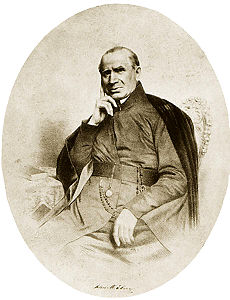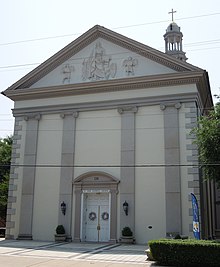
Francis Ignatius Neale, also known as Francis Xavier Neale, was an American Catholic priest and Jesuit who led several academic and religious institutions in Washington, D.C., and Maryland. He played a substantial role in the Jesuit order's resurgence in the United States.

Saint John's Catholic Prep is a private, Roman Catholic, coeducational, college preparatory high school in Buckeystown, Maryland, located just southwest of Frederick City. At the time of its founding in 1829, it was located on Second Street in eastern downtown Frederick. Beginning in 1958 and for 45 years thereafter, the school was housed in the historic "Prospect Hall" mansion, (1787–1803), also just southwest of Frederick. St. John's was the first independent Roman Catholic school in the state of Maryland. It was also the first Roman Catholic secondary school in the state of Maryland.

Anthony Kohlmann was an Alsatian Catholic priest, missionary, theologian, and Jesuit educator. He played a decisive role in the early formation of the Archdiocese of New York, where he was the subject of a lawsuit that for the first time recognized the confessional privilege in the United States, and served as the president of Georgetown College from 1817 to 1820.
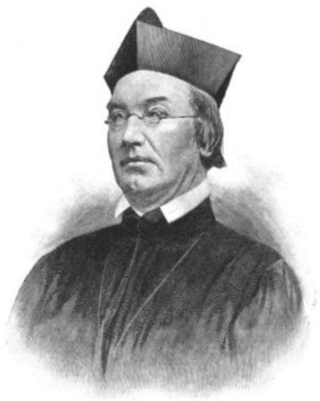
John Early was an Irish-American Catholic priest and Jesuit educator who was the president of the College of the Holy Cross and Georgetown University, as well as the founder and first president of Loyola College in Maryland. Born in Ireland, he emigrated to the United States at the age of nineteen. Upon his arrival, he enrolled at Mount St. Mary's Seminary in Maryland and entered the Society of Jesus, completing his education at Georgetown University in Washington, D.C.

St. John's Cemetery is a Roman Catholic cemetery located in Frederick, Maryland. The cemetery is operated by St. John the Evangelist Holy Catholic Church in Frederick, Maryland. The cemetery is located at East 3rd Street Frederick, Maryland 21701.
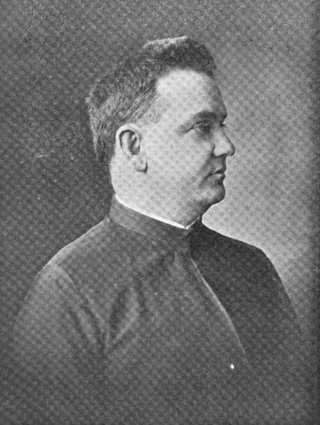
William George Read Mullan, SJ, was an American Jesuit and academic who served as President of Boston College from 1898 to 1903 and President of Loyola University Maryland from 1907 to 1908.

Bernard A. Maguire was an Irish-American Catholic priest and Jesuit who served twice as the president of Georgetown University. Born in Ireland, he emigrated to the United States at the age of six, and his family settled in Maryland. Maguire attended Saint John's College in Frederick, Maryland, and then entered the Society of Jesus in 1837. He continued his studies at Georgetown University, where he also taught and was prefect, until his ordination to the priesthood in 1851.
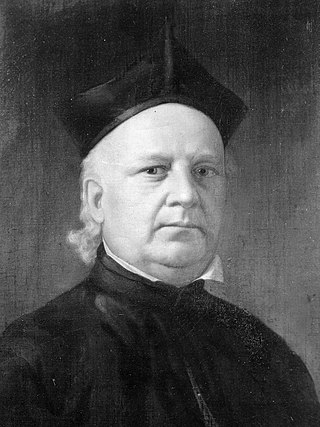
James A. Ryder was an American Catholic priest and Jesuit who became the president of several Jesuit universities in the United States. Born in Ireland, he immigrated with his widowed mother to the United States as a child, to settle in Georgetown, in the District of Columbia. He enrolled at Georgetown College and then entered the Society of Jesus. Studying in Maryland and Rome, Ryder proved to be a talented student of theology and was made a professor. He returned to Georgetown College in 1829, where he was appointed to senior positions and founded the Philodemic Society, becoming its first president.

Joseph Havens Richards was an American Catholic priest and Jesuit who became a prominent president of Georgetown University, where he instituted major reforms and significantly enhanced the quality and stature of the university. Richards was born to a prominent Ohio family; his father was an Episcopal priest who controversially converted to Catholicism and had the infant Richards secretly baptized as a Catholic.
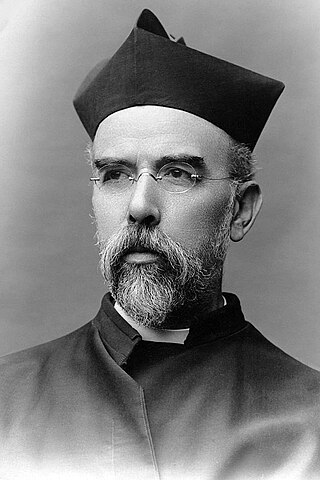
Joseph J. Himmel was an American Catholic priest and Jesuit. For much of his early life, he was a missionary throughout the northeast United States and retreat master. Later in life, he was president of Gonzaga College and Georgetown University in Washington, D.C.
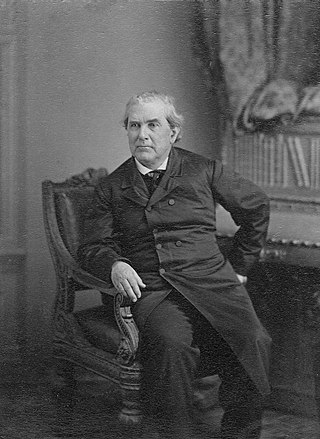
Charles Henry Stonestreet was an American Catholic priest and Jesuit who served in prominent religious and academic positions, including as provincial superior of the Jesuit Maryland Province and president of Georgetown University. He was born in Maryland and attended Georgetown University, where he co-founded the Philodemic Society. After entering the Society of Jesus and becoming a professor at Georgetown, he led St. John's Literary Institution and St. John the Evangelist Church in Frederick, Maryland. He was appointed president of Georgetown University in 1851, holding the office for two years, during which time he oversaw expansion of the university's library. The First Plenary Council of Baltimore was held at Georgetown during his tenure.
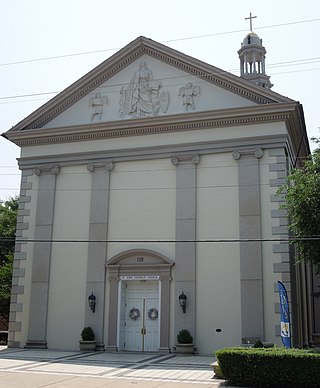
St. John the Evangelist Catholic Church is a parish of the Roman Catholic Church in Frederick, Maryland, part of the Archdiocese of Baltimore. Founded in 1763, after the repeal of the British penal laws, as the first Catholic church in Frederick County, the parish occupied two former buildings before the completion of the present Greek Revival church in 1837. At the time of its opening, the church was the largest parish church in the United States and was the first Catholic church to be consecrated in the Diocese of Baltimore. Today, the church remains the tallest building in the city of Frederick.

John William Beschter was a Catholic priest and Jesuit from the Duchy of Luxembourg in the Austrian Netherlands. He emigrated to the United States as a missionary in 1807, where he ministered in rural Pennsylvania and Maryland. Beschter was the last Jesuit pastor of St. Mary's Church in Lancaster, as well as the pastor of St. John the Evangelist Church in Baltimore, Maryland. He was also a priest at several other German-speaking churches in Pennsylvania.

Samuel A. Mulledy was an American Catholic priest and Jesuit who served as president of Georgetown College in 1845. Born in Virginia, he was the brother of Thomas F. Mulledy, who was a prominent 19th-century Jesuit in the United States and a president of Georgetown. As a student at Georgetown, Samuel was one of the founding members of the Philodemic Society, and proved to be a distinguished student, which resulted in his being sent to Rome to complete his higher education and be ordained to the priesthood. Upon his return to the United States, he became the master of novices at the Jesuit novitiate in Maryland, before being named president of Georgetown. He sought to be relieved of the position after only a few months, and returned to teaching and ministry.
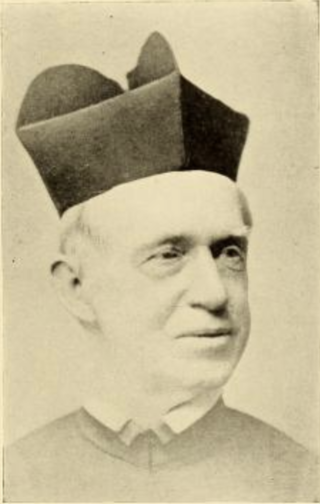
William Francis Clarke was an American Catholic priest and Jesuit who held several senior positions at Jesuit institutions in Maryland and Washington, D.C. Born in Washington, he descended from several early colonial families of Maryland. He was educated at Gonzaga College and its successor institutions during the suppression of the Society of Jesus, followed by Georgetown College. After his entrance into the Jesuit order, he taught for several years at Georgetown, and became the pastor of St. Joseph's Church in Baltimore, where he took uncommon measures to integrate black Catholics and Italian immigrants into parish life.
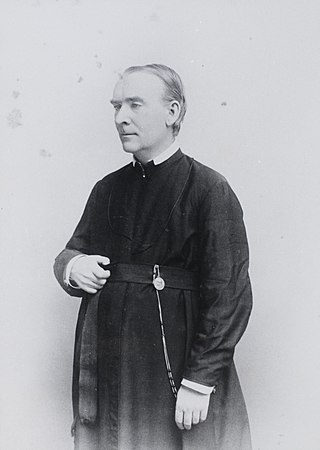
Edward Ignatius Devitt was a Canadian American priest, Jesuit, and historian of the American Catholic Church. Born in Saint John, New Brunswick, he moved with his family to Boston, Massachusetts, at a young age. He studied in public schools in the city before enrolling at the College of the Holy Cross. Devitt spent two years there, and then entered the Society of Jesus in 1859. He studied at the novitiate in Frederick, Maryland, and at the newly opened Woodstock College. He briefly taught at the Washington Seminary during his studies, and after graduating, was a professor for the next thirty years at Holy Cross, Woodstock, and Georgetown University.

Robert Wasson Brady was an American Catholic priest who led several Jesuit institutions in the United States. He served twice as the president of the College of the Holy Cross from 1867 to 1869 and from 1883 to 1887. He was also the second president of Boston College from 1869 to 1870 and the provincial superior of the Jesuits' Maryland Province from 1877 to 1882.

Robert James Fulton was an American Catholic priest and Jesuit who twice served as the president of Boston College, from 1870 to 1880 and 1888 to 1891. He was influential in the early years of Boston College, as he was in charge of all the school's academic affairs.
Joseph O'Callaghan was an American Catholic priest and Jesuit. Born in Massachusetts, he studied in Canada and then at the College of the Holy Cross before entering the Society of Jesus in 1844. O'Callaghan taught at Georgetown University before becoming the president of Loyola College in Maryland in 1860, where he remained for three years. In 1869, he was sent to Rome to represent the Jesuit Province of Maryland at the congregation of procurators. He died at sea while returning from the congregation.
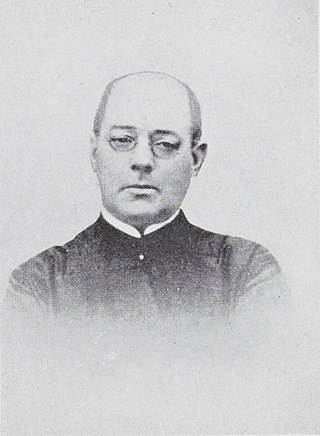
Edward Victor Boursaud was an American Catholic priest and Jesuit who was the president of Boston College from 1884 to 1887. Raised in New York City and France, he studied at Mount St. Mary's College in Maryland before entering the Society of Jesus in 1863. For the next 18 years, he studied and taught at Jesuit institutions, including Boston College, Georgetown College, and Woodstock College, as well as the novitiate in Frederick, Maryland. In 1881 and 1887, he served three-year terms in Italy as the assistant secretary to the Jesuit Superior General for the English-speaking world.
